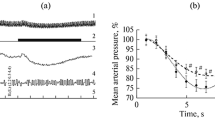Summary
It was shown in 11 decerebrated cats, that cooling of a small and well defined area on the ventral surface of the medulla will cause respiratory arrest if the contralateral area of the medulla, the vagi and sinus nerves are eliminated. This confirms earlier observations obtained in anesthetized cats.
Apnea was also produced by local superfusion of 2% procain with simultaneous flushing of the immediate surrounding area with mock spinal fluid. Local application of a small sponge soaked with 1% procain had the same effect.
Electrical stimulation of femoral nerves or posterior roots which results in hyperventilation on the decerebrated cat failed to show any effect during periods of cold blockade. There was no respiratory response to direct stimulation of the hypothalamus in an anesthetized cat during cooling.
Electrical stimulation of one sinus nerve caused an increase of ventilation. Sinus nerve stimulation during apnea induced by cold blockade resulted in rhythmical respiration.
It is concluded from these experiments: Blocking of the area under discussion on the ventral surface of the medulla, inhibits all structures responsible for the central CO2-sensitivity in the deafferentiated animal. There was no response to non-specific stimuli of the respiratory center after elimination of central and peripheral chemosensitivity. The respiratory centers apparently depend on specific stimuli to support rhythmical respiration.
Zusammenfassung
An 11 intercolliculär decerebrierten Katzen wurde geziegt, daß Kälteblockade eines eng umschriebenen Feldes auf der ventralen Oberfläche der Medulla oblongata, wie früher für anaesthesierte Tiere beschrieben, zu Atemstillstand führt, wenn die kontralaterale Stelle auf der Medulla oblongata, die Sinusnerven und die Vagi ausgeschaltet sind.
Zu Atemstillstand kam es auch, wenn statt der Kälteblockade 2% Novocain durch lokale Superfusion bei gleichzeitiger Gegenspülung der Umgebung mit künstlichem Liquor angewandt wurde, oder wenn ein mit 1% Novocain getränkter Tupfer lokal aufgelegt wurde.
Außerdem führte Kälteblockade zu Atemstillstand, wenn durch kontinuierliche auch während der Kälteblockade anhaltende elektrische Reizung eines N. femoralis oder hinterer Lumbalwurzeln an decerebrierten Katzen oder des Hypothalamus an einer anaesthesierten Katze Steigerungen der Ventilation ausgelöst worden waren.
Elektrische Reizung eines Sinusnerven führte zu Atemsteigerungen. Bei Sinusnervenreizung während eines durch Kälteblockade ausgelösten Atemstillstands kam es zu rhythmischer Atmung.
Aus diesen Untersuchungen wird geschlossen, daß mit der Ausschaltung der beschriebenen Felder auf der ventralen Oberfläche der Medulla oblongata am sonst desafferentierten Tier die Gesamtheit der für die zentrale CO2-Empfindlichkeit verantwortlichen Strukturen erfaßt ist, daß nach Ausschaltung der zentralen und der peripheren Chemosensibilität eine unspezifische Aktivierung der Atmungszentren unwirksam ist und daß die Atmungszentren zur Ausbildung einer rhythmischen Atmung von spezifischen Antrieben abhängig sind.
Similar content being viewed by others
Literatur
Alexander, R. S.: Tonic and reflex functions of medullary sympathetic cardiovascular centers. J. Neurophysiol.9, 205–217 (1946).
Baumgarten, R. v., andG. C. Salmoiraghi: Respiratory neurones in the goldfish. Arch. ital. Biol.100, 31–47 (1962).
Burns, B. D., andG. C. Salmoiraghi: Mechanism of the repetitive discharge of respiratory neurones. Physiologist1, 7 (1958).
Cozine, R. A., andS. H. Ngai: Medullary surface chemoreceptors and regulation of respiration in the cat. J. appl. Physiol.22, 117–121 (1967).
Euler, C. v., andU. Söderberg: Medullary chemosensitive receptors. J. Physiol. (Lond.)118, 545–554 (1952).
Hall, M.: Memoirs on the nervous system. London: Sherwood, Gilbert and Piper 1837.
Hugelin, A., andM. I. Cohen: The reticular activating system and respiratory regulation in the cat. Ann. N.Y. Acad. Sci.109, 568–603 (1963).
Loeschcke, H. H., J. de Lattre, M. E. Schläfke, andC. O. Trouth: Effects on respiration and circulation of electrically stimulating the ventral surface of the Medulla oblongata. Respiration Physiology (in Vorbereitung).
Mitchell, R. A., H. H. Loeschcke, W. H. Massion, andJ. W. Severinghaus: Respiratory responses mediated through superficial chemosensitive areas on the medulla. J. appl. Physiol.18, 523–533 (1963).
——,J. W. Severinghaus, B. W. Richardson, andW. H. Massion: Region of respiratory chemosensitivity on the surface of the medulla. Ann. N.Y. Acad. Sci.109, 661–681 (1963).
Müller, J.: Handbuch der Physiologie des Menschen für Vorlesungen. Zweiten Bandes erste Abteilung. Coblenz: J. Hölscher 1837.
Petrovický, P.: Über die Glia marginalis und oberflächliche Nervenzellen im Hirnstamm der Katze. Z. Anat. Entwickl.-Gesch.127, 221–231 (1968).
Rach, E.: Quo modo medulla oblongata, ut respirandi motus efficiat, incitetur. Diss. inaug. Regiomonti, Pr. 1863.
Salmoiraghi, G. C., andB. D. Burns: Localization and patterns of discharge of respiratory neurones in brain-stem of cat. J. Neurophysiol.23, 2–13 (1960a).
Schiff, (J.) M.: Lehrubuch der Muskel-und Nervenphysiologie. Lahr: M. Schauenburg & Co. 1858/59.
Schläfke, M., u.H. H. Loeschcke: Lokalisation eines an der Regulation von Atmung und Kreislauf beteiligten Gebietes an der ventralen Oberfläche der Medulla oblongata durch Kälteblockade. Pflügers Arch. ges. Physiol.297, 201–220 (1967).
Schläfke, M. W.-R. See, andH. H. Loeschcke: Ventilatory response to alteration of H+ concentration in small areas of the ventral medullary surface. Respiration Physiology (in Vorbereitung).
Vassella, F.: Lokalisation eines inspiratorischen Zentrums in der Medulla oblongata des Kaninschens. Helv. physiol. pharmacol. Acta19, 166–182 (1961).
Vierordt, K.: Respiration. Hdwb. Physiol. (Wagner)2, 828–916 (1844).
Volkmann, A. W.: Über die Bewegungen des Athmens und Schluckens, mit besonderer Berücksichtigung neurologischer Streitfragen. Arch. Anat. Physiol. wiss. Med. 332–360 (1841).
Winterstein, H.: Die automatische Tätigkeit der Atemzentren. Pflügers Arch. ges. Physiol.138, 159–166 (1911).
Wittich, W. v.: Über die Beziehungen der Medulla oblongata zu den Atembewegungen bei Fröschen. Virchows Arch. path. Anat.37, 322–345 (1866).
Wyss, O. A. M.: Die tonische Innervation des Zwerchfells. Pflügers Arch. ges. Physiol.244, 712–735 (1941).
—: Structure anatomique et fonctionnelle du centre respiratoire. Arch. int. Studi neurol.1, 1–25 (1950).
Author information
Authors and Affiliations
Additional information
Mit Unterstützung durch die Deutsche Forschungsgemeinschaft
Rights and permissions
About this article
Cite this article
Schläfke, M.E., See, W.R., Massion, W.H. et al. Die Rolle „spezifischer” und unspezifischer Afferenzen für den Antrieb der Atmung, untersucht durch Reizung und Blockade von Afferenzen an der decerebrierten Katze. Pflugers Arch. 312, 189–205 (1969). https://doi.org/10.1007/BF00586928
Received:
Issue Date:
DOI: https://doi.org/10.1007/BF00586928




